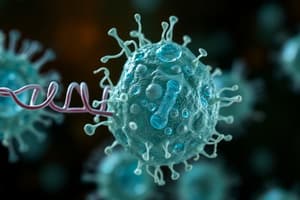Podcast
Questions and Answers
What role does eIF-2 play in translation?
What role does eIF-2 play in translation?
- It aids in the initiation phase of translation. (correct)
- It terminates the translation process.
- It helps in splicing exons together.
- It facilitates the elongation of amino acids.
How does RNA splicing affect exons?
How does RNA splicing affect exons?
- It connects exons but may affect their expression. (correct)
- It can eliminate all exons from the final mRNA.
- It alters the amino acid sequence of the resulting protein.
- It increases the number of exons present in mRNA.
Which stage of translation involves bringing amino acids to the ribosome?
Which stage of translation involves bringing amino acids to the ribosome?
- Transcription
- Initiation
- Elongation (correct)
- Termination
Why is gene expression critical for characteristics such as height and eye color?
Why is gene expression critical for characteristics such as height and eye color?
What happens when there is an increased translation of certain genes in cancer cells?
What happens when there is an increased translation of certain genes in cancer cells?
What is the primary function of transcription factors in gene expression?
What is the primary function of transcription factors in gene expression?
Which component blocks the RNA polymerase from performing transcription in the lac operon?
Which component blocks the RNA polymerase from performing transcription in the lac operon?
What happens to mRNA during the post-transcription process?
What happens to mRNA during the post-transcription process?
In prokaryotic cells, how do transcription and translation occur?
In prokaryotic cells, how do transcription and translation occur?
Which of these factors can influence gene expression?
Which of these factors can influence gene expression?
What is the function of an enhancer in gene expression?
What is the function of an enhancer in gene expression?
What characterizes gene expression in eukaryotic cells when compared to prokaryotic cells?
What characterizes gene expression in eukaryotic cells when compared to prokaryotic cells?
What occurs in the presence of lactose in the lac operon?
What occurs in the presence of lactose in the lac operon?
Flashcards
Gene Expression
Gene Expression
The process by which a gene's instructions are used to create a functional product, typically a protein.
Promoters
Promoters
Regions of DNA that control the start of transcription. They act like 'on' switches for genes.
Enhancers
Enhancers
Regions of DNA that enhance transcription by boosting the activity of promoters.
Transcription Factors
Transcription Factors
Signup and view all the flashcards
Lac Operon Repression
Lac Operon Repression
Signup and view all the flashcards
Transcription
Transcription
Signup and view all the flashcards
RNA Splicing
RNA Splicing
Signup and view all the flashcards
Introns
Introns
Signup and view all the flashcards
eIF-2
eIF-2
Signup and view all the flashcards
Translation
Translation
Signup and view all the flashcards
Codon
Codon
Signup and view all the flashcards
Stop codon
Stop codon
Signup and view all the flashcards
Study Notes
Gene Expression
- Gene expression is the process of using a gene's information to create a functional protein.
- Not all genes are expressed in all cells or at all times.
- Gene expression is regulated.
- Certain body parts do not need certain genes, so those genes are not expressed.
Prokaryotic Gene Expression
- Prokaryotic organisms (like bacteria) express genes primarily through transcription and translation happening in the same location (cytoplasm).
- Transcription and translation occur simultaneously.
- Control of gene expression is primarily at the transcription level.
Eukaryotic Gene Expression
- Eukaryotic organisms (like animals and plants) have genes that must be transcribed and translated in different locations (nucleus and cytoplasm).
- Transcription occurs in the nucleus.
- RNA must be processed before translation.
- There are more opportunities for gene regulation in eukaryotes due to having a nucleus and more steps in the process.
Transcription Factors
- Proteins that affect transcription and translation.
- Promoter regions help RNA polymerase start transcription .
- Enhancers are regions that increase transcription.
- Repressors are regions that block RNA polymerase from starting transcription; this is important when the gene is not needed.
- Transcription factors are environmentally affected.
- UV light
- Lack of nutrients
- Too much of something.
Lac Operon Example
- Lactose is a sugar that bacteria want to break down.
- The presence of lactose causes the repressor to be removed.
- Transcription happens.
- mRNA is used to make a protein , the enzyme to break down lactose.
- When lactose is absent, the repressor blocks transcription and no enzyme is created.
Gene Regulation in Eukaryotes (Further Info)
- Transcription: DNA is rewritten into mRNA by DNA polymerase.
- mRNA carries the gene information and travels to the cytoplasm for translation.
- Post-transcriptional modifications: mRNA maturation processes. This includes examining the mRNA strand and removing regions of RNA (Introns) and putting the other useful pieces together (Exons). This is done before leaving the nucleus.
- Introns are non-coding pieces of DNA.
- Exons are the regions that hold the necessary code.
Translation
- Translation uses the mRNA to make a polypeptide chain of amino acids that will become a protein.
- Initiation: mRNA and ribosomes combine.
- Elongation: Amino acids are added to the chain by the ribosome.
- Termination: The polypeptide chain is released.
- Post-translation: Chemical adjustments to protein can change function. This can alter the protein's structure and function.
Why is Gene Expression Important?
- Impacts height
- Impacts eye color
- Impacts blood type
- Impacts hair color
- Affects cell functioning in the body
- Important when cells are not working correctly; e.g., cancer.
- Mutations can increase translation of genes that speed up cell division (e.g., cancer). This increases the division of cancer cells.
Studying That Suits You
Use AI to generate personalized quizzes and flashcards to suit your learning preferences.




